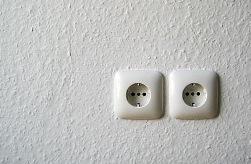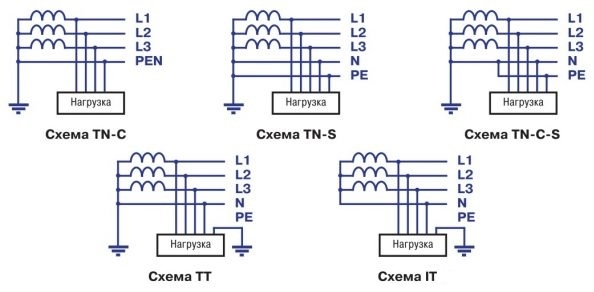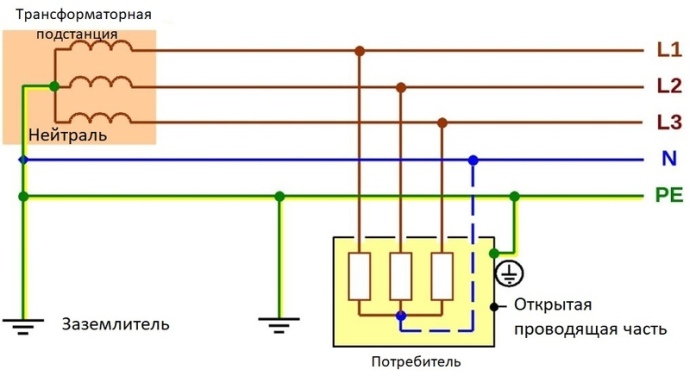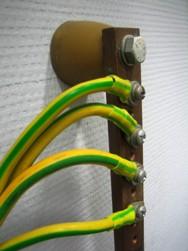Categories: Novice electricians, Electrician at home
Number of views: 120035
Comments on the article: 13
Classification of electrical system grounding systems
 Classification of grounding systems of electrical installations and modernization of apartment wiring. Application Experience.
Classification of grounding systems of electrical installations and modernization of apartment wiring. Application Experience.
For proper repair or modernization of wiring, you need to know exactly which grounding system is applied at the facility. Your safety depends on this, in addition, it is important when drawing up a reconstruction project. In some cases, for example, a three-core cable is used, and in others four and five-core cable.
Classification electrical grounding systems according to IEC
The International Electrotechnical Commission and, with its submission, the 7th edition of the PUE (Electrical Installation Rules) distinguish 3 grounding systems and several of their subsystems.
1. TN system (subsystems TN-C, TN-S, TN-C-S);
2. TT system;
3. IT system.
TN system
TN system, this dead earthed system, in which the open conductive parts of the electrical installation are connected to the grounded neutral source with the help of zero protective conductors.
Term dead earthed neutral means that at the transformer substation, the neutral (zero) is connected directly to the ground loop (grounded).
TN-C Subsystem, this is TN, in which the zero protective and zero working conductors are combined along its entire length, i.e. protective grounding.
TN-S - This is a system in which the zero protective and zero working conductors are separated throughout. This is the safest, but also the most expensive system.
Subsystem TN-C-S Is an intermediate option. In it, the zero protective and zero working conductors are combined in some part of it. Usually this is the main shield of the building (protective grounding is supplemented by protective grounding). Further throughout the building, these conductors are separated. This system is optimal in terms of price-quality ratio.
IT system
This is a system in which zero of the source is isolated from the ground, or grounded through devices having high resistance, and the open conductive parts of the electrical installation are grounded using grounding devices. Now the IT system is almost never used.
TT system
This is a system in which the source zero is grounded and the exposed conductive parts of the electrical installation are grounded using a grounding device that is electrically independent of the source ground zero. In other words, it uses its own ground loop at the facility in no way connected to zero.
Today this system is the main one for mobile structures, for example, change houses, carriages, etc. Note that coordinating the use of such a system is more difficult than TN. Becomes mandatory RCD application, high-quality grounding is required (4 Ohms for 380 V), there are features when selecting circuit breakers.
Illustration for comparing differences in power supply schemes for different grounding systems:

Scheme of the safest grounding system TN-S:

What earthing system for electrical installations to use and how to upgrade ?!
 Based on the foregoing, it is best to use the TN grounding system.
Based on the foregoing, it is best to use the TN grounding system.
The TN-C system has been used before and cannot be recommended for new housing.
The TN-S system is good for everyone, but it is rarely used and expensive. The best option so far is the TN-C-S system.
Let us dwell on the typical difficulties and errors encountered in the modernization of grounding systems.
1. If we consider a private house in which the wiring is already done with a three-wire wire (phase, zero, grounding), then replacing the TN-C with the TN-C-S is quite simple. You only need to make a good grounding, connect it to the input electrical panel and connect PE wires of outlets and lamps (usually a yellow-green wire) to the point of connection of zero and ground (N and PE).
2. In an apartment or apartment building that is not equipped with a ground loop, this cannot be done.Wiring, of course, is better done with a three-wire cable, but ground wire no need to connect, nor in outlets (lamps) not in electrical panel.
The reason is that if you connect this wire to zero wiring (there is nowhere else to connect it except for the battery, which is forbidden), then due to the drop in voltage in the neutral wire from the currents of the switched-on loads, the cases of your equipment will be energized relative to the ground ( batteries, pipes, etc.).
3. During operation, there are other incidents, for example, after eliminating the accident, electricians mix up the zero and phase wires. Neighbors who do not have a neutral wire on the equipment case are not at risk, and you have a case under the phase potential!
4. There are frequent cases of input cable zero burning occurring during phase imbalance, in which case there will also be a dangerous potential on the case.
Based on the foregoing, it follows the need to use RCD or difavtomatov. These are devices that turn off the 220/380 V network when minor (but sensitive!) Currents of 10-30 mA flow through the human body. The disadvantage of these devices is that they will operate at any leakage currents, for example, when neighbors spilled you. It is very difficult find where these leaks occur.
So, when repairing wiring, use the TN-C-S grounding system. Route wiring three-core copper cable with colored insulation of cores (e.g. VVG NG).
If the house does not have a ground loop, do not connect the ground wire to zero. For wiring in rooms where there is a lot of moisture, use difavtomaty and RCD.
bgv.electricianexp.com - electrical engineering and electronics for beginners,electrician in the apartment, do-it-yourself electrician.
Read also on this topic:How to determine the type of grounding system in the house
See also at bgv.electricianexp.com
:
